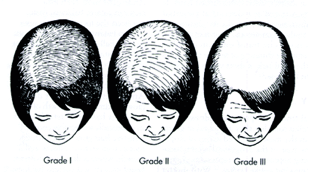Hair Loss In Women
Female pattern baldness is very common. Studies show that incidence of hair loss in women increases from 3% in their twenties to 30% of women in their eighties. Approximately one quarter of all women are affected by some hair loss by the time they are in their fifties.
Women go to great lengths to hideit cosmetically with various hair styles and treatments but the hair loss is common and can be emotionally traumatic.

- Grade 1 female baldness is the least severe with thinning on the top of the head.
- Grade 2 hair loss in women is more significant with areas of the scalp showing through thinning hair.
- Grade 3 patients may completely lose hair on the crown of the head. In this case, more donor hair will be required to obtain full coverage.

- Diffuse thinning of hair over the entire scalp, often with more noticeable thinning toward the back of the scalp.
- Diffuse thinning over the entire scalp, with more noticeable thinning toward the front of the scalp but not involving the frontal hairline.
- Diffuse thinning over the entire scalp, with more noticeable thinning toward the front of the scalp, involving and sometimes breaching the frontal hairline.
Unlike the case for men, thinning scalp hair in women due to androgenetic alopecia does not uniformly grow smaller in diameter (miniaturize). Women with hair loss due to androgenetic alopecia tend to have miniaturizing hairs of variable diameter over all affected areas of the scalp.
While miniaturizing hairs are a feature of androgenetic alopecia, miniaturization may also be associated with other causes and is not in itself a diagnostic feature of androgenetic alopecia.
In post-menopausal women, for example, hair may begin to miniaturize and become difficult to style. The precise diagnosis should be made by a physician hair restoration specialist.
It is important to note that female pattern hair loss can begin as early as the late teens to early 20s in women who have experienced early puberty. If left untreated, this hair loss associated with early puberty can progress to more advanced hair loss if it is left untreated.
CAUSES OF HAIR LOSS IN WOMEN
In women more often than in men, hair loss may be due to conditions other than androgenetic alopecia. Some of the most common of these causes are:
Trichotillomania – compulsive hair pulling. Hair loss due to trichotillomania is typically patchy, as compulsive hair pullers tend to concentrate the pulling in selected areas. Hair loss in women due to this cause cannot be treated effectively until the psychological or emotional reasons for trichotillomania are effectively addressed. Therefore, hair transplantation would not be an appropriate treatment option.
Alopecia areata – a possibly autoimmune disorder that causes patchy hair loss in women that can range from diffuse thinning to extensive areas of baldness with “islands” of retained hair. Medical examination is necessary to establish a diagnosis.
Triangular alopecia – loss of hair in the temporal areas that sometimes begins for a woman in childhood. Hair loss may be complete, or a few fine, thin-diameter hairs may remain. The cause of triangular alopecia is not known, but the condition can be treated medically or surgically.
Scarring alopecia – hair loss due to scarring of the scalp area. Scarring alopecia typically involves the top of the scalp and occurs predominantly in women. The condition frequently occurs in African-American women and is believed to be associated with persistent tight braiding of scalp hair. A form of scarring alopecia also may occur in post-menopausal women, associated with inflammation of hair follicles and subsequent scarring. We also refer to this as traction alopecia, a slow chronic pull on the hair root that eventually kills the root system causing balding.
Telogen effluvium – A common type of hair loss caused when a large percentage of scalp hairs are shifted into “shedding” phase. The causes of telogen effluvium in a woman may be hormonal, nutritional, drug-associated, or stress-associated. Loose-anagen syndrome—a condition occurring primarily in fair-haired persons in which scalp hair sits loosely in hair follicles and is easily extracted by combing or pulling. The condition may appear in childhood, and may improve as the person ages.
Postpartum Alopecia – Another common form of hair loss, postpartum alopecia is caused by hormonal changes during the course of a pregnancy. The changes cause an alteration in the growth pattern of the hair follicles. There is usually very little sign of these changes during the pregnancy itself, but rather a sudden and very excessive loss of hair from three to nine months after the birth of the child. While this is often very traumatic for the new mother suffering from the hair loss, the hair’s growth cycle typically returns to normal within a year after the end of the pregnancy. Therefore, hair transplantation is not a necessary treatment option.
Hypopituitarism and Thyroid Disorders – Female hair loss can be the result of a hormonal change or imbalance. There has been a report describing a young women with hypopituitarism who presented with clinical and histological features of female pattern baldness in the absence of detectable levels of circulating androgens (testosterone and other male hormones) showing this pattern of hair loss is not androgen dependent. Hair transplantation is usually not an initial treatment option in these instances.
Accident or Surgery Related – Women who have had facelifts or other procedures in the scalp that have left scars or, as in the case of brow lifts, has left the hairline too high. In general, these types of hair loss respond well to transplants.
If you are a woman with thinning or lost scalp hair, your first necessary step is to have the condition correctly diagnosed by a NuHart hair restoration physician specialist.
Concerned About Your Hair Loss Troubles?
Set aside those worries, for now, we at NU/HART Philippines are more than happy to help you deal with this problem. All you have to do is send your inquiries to: info@nuhartclinic.com.ph
Subscribe To Our Newsletter
Stay in touch with us to get latest news and special offers.
Why NU/HART?
These numbers speak for themselves!